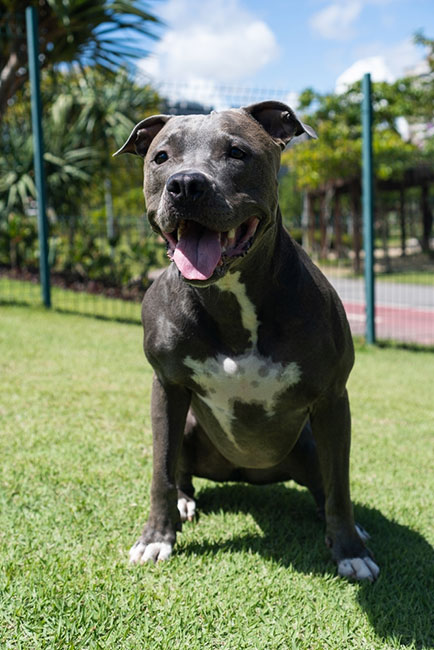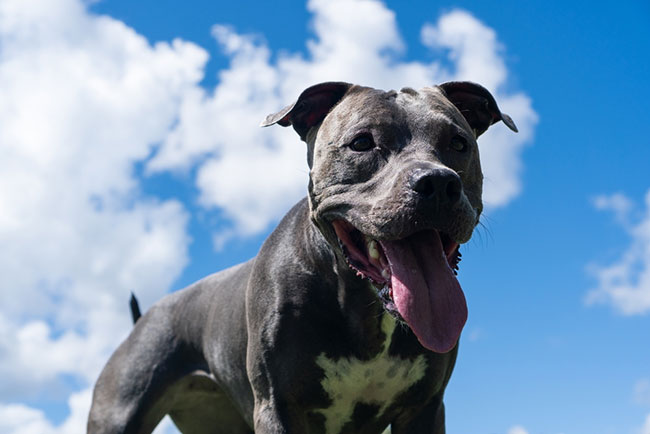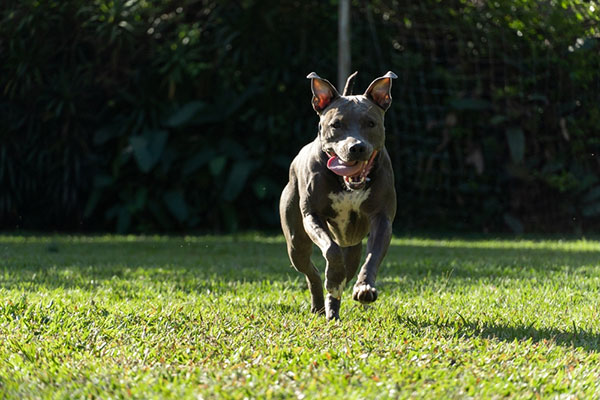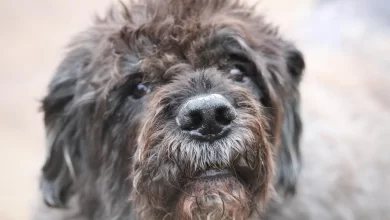
Waghound.com is an Amazon Associate, and we earn from qualifying purchases.
The Blue Nose Pitbull caught my attention a while ago, and most of you can probably guess why: it was because of the color “blue” in its name.
Looking into its history and biological buildup, the Blue Nose Pitbull is one of a kind. If you think it’s a separate breed, you need to get your facts straight because it isn’t.
Later on in the article, we’ll look at some more detail-specific information about the breed which is quickly becoming a really popular breed. But for now, on a more surface level, let me reassure you… one of the reasons they’re so popular right now is because of the “blue” hue of their body.
So if you’re interested in buying a Blue Pitbull, or if you want to find out more about them to see if they’re the right dog breed for you, you’re at the right place.
We at Waghound have compiled a guide to give you valuable information and help you decide.
Blue Nose Pitbull vs Regular Pit Bull: Understanding the Difference

When it comes to pit bulls, there are various types and breeds, and the blue nose pit bull is one of them. Many people are often confused about the difference between a blue nose pitbull and a regular pit bull. The main difference between the two is the coat color and pigmentation of their nose. Blue nose pit bulls have a grayish-purple coat and a nose of the same color, which makes them stand out from the regular pit bull. They also have blue eyes, which is a unique trait in the pit bull breed. However, apart from their appearance, there is no difference between a blue nose pitbull and a regular pit bull in terms of temperament, behavior, or physical abilities.
Blue Nose Pitbull- About The Breed
Let’s start with understanding the breed. The Blue Nosed Pitbull is just another variation of the American Pitbull Terrier.
Blue Nose Pitbull is not a new breed, it’s just that it’s a different color. If you really think about it, and if you look up close, it’s mostly grey with a tinge of blue. This hue can also be found in their skin, eyes, and toenails.
These features make them pretty unique.
The Reason for the Color Blue

Why do they have this hue? Well, this color is due to their recessive genes which actually lead to a lower level of melanin production.
Recessive genes? What’s that? Recessive genes refer to the genes that lead to animals possessing rare features. In fact, the blue nose of the Pitbull is unique because unless both parents have the recessive gene, it is impossible to have a Pitbull born with this blue color.
Associating Pitbulls with fights and with being aggressive is not uncommon. However, realistically, only humans are to blame. Tragic, isn’t it?
Why? Pitbulls love to play games and would do anything to please their owners. In the past, many owners encouraged Pitbulls to fight against one another. This lead to this breed to be associated with dogfights and instilled fear in the hearts of the general population creating the perception that Pitbulls are angry, aggressive and dangerous.
In reality, this could not possibly be farther from the truth. Pitbulls are actually a gentle and family-loving dog, and they are very trainable.
Important Read: Best Dog Training Collars – Reviews & Buyer’s Guide
Physical Characteristics of Blue Nose Pitbulls
Looks can be deceiving, especially with this breed. At first glance, they appear to be an average medium-sized dog of about 30 to 50 pounds, but sometimes they can weigh as much as 85 pounds. With strong legs, a broad chest, and a sturdy, confident demeanor, they can sometimes seem intimidating.
An average Pitbull stands from 1.5 feet to 2 feet tall and they have lovely coats—soft, short and silky. As their name suggests, they can be slightly bluish-grayish color.
Personality & Temperament of Blue Nose Pitbulls
As mentioned above, these Pitbulls have often been labeled as aggressive because of their history, having been bred for and used in dogfights.
All of which is untrue of their natural demeanor.
Pitbulls are actually very loyal and loving family dogs with a very sweet nature.
They are not only friendly and intelligent but, they are also very protective. It’s typically only in that situation—out of loyalty and protection of their owner—that if the situation requires, they may tend to behave aggressively.
This behavior stems from fear—they have an inherent need to feel secure and protect their family.
And this can be attributed to the fact they feel emotions, just like humans.
Blue Nose Pitbulls are Emotional
Of course! Blue pits are actually very emotional. If you ignore them or yell at them, they’ll react with disappointment and pain, including giving you the silent treatment.
They can also be very stubborn at times. They don’t respond well to other dogs because they can be quite jealous when they’re not the center of attention.
Unless you train them from the time they’re a puppy to be less jealous around other dogs, you will have trouble every time you pet another dog in front of your Blue pit bulls—they will get jealous.
Blue Nose Pitbulls Make Good Friends with Kids
With that being said, they love kids. They are known to be very affectionate and gentle with children. Since they have a high tolerance for pain, they don’t mind being hugged or cuddled tightly—which quickly earns them the prize favorite place in the household.
While they don’t look very smart and may seem to have somewhat clumsy faces and goofy behavior, they are actually very intelligent. In a nutshell, they are an excellent breed for the whole family, especially kids.
They respond extremely well to training and if positive behavior is reinforced, with love and discipline, you’ll have earned yourself an agreeable, loving, lifelong companion.
Taking Care of a Blue Nose Pitbull — Exercise, Feeding, and Grooming

Feeding
Nutrition is an essential component to ensure the quality of life for your pet. Although dogs are omnivores in nature yet—during their growth years—a protein diet is very important.
Both raw and commercial foods are important for your dog’s development. The amount of food you give your dog will depend on a number of factors like their age, lifestyle and activity level.
A puppy will need more nutrition than his adult counterparts.
For example, puppies need a minimum of 22% protein in their diet, whereas, adults need a minimum of about 18% protein. It’s ideal to feed a Blue Nose Pitbull puppy three times a day; feel free to opt for one cup per meal.
Similar to the puppy, an adult Pitbull can also be fed two to three times a day. Blue Nose Pitbulls are extremely active and need to get a lot of exercises daily.
Exercise & Training
Blue Nose Pitbulls are full of energy and they have to let it out—they need to be able to run around and burn off the energy.
If they don’t get a proper amount of exercise, they can become lethargic, aggressive, overweight and moody. Simply put, a physically active lifestyle makes them feel more complete.
Take your dog for a walk or run every day; it will help them to burn off extra calories and fulfill their extremely energetic nature.
Grooming
Firstly, understand that this is a very active breed and since they play a lot, they will sweat, sweat, sweat.
So, unless you want a stinky dog around the house, make sure to bathe them regularly. Luckily, their coats are short and easy to maintain, so coat brushing once a week should be enough.
Remember they are prone to allergies and skin problems, so keep an eye out for any kind of rash on their skin.
Secondly—like all canines—you need to regularly brush their teeth, trim their nails and clean their ears.
And finally, if you live in an area where the temperature is hot, remember they aren’t very good at regulating their body temperatures.
It’s better to keep them indoors, air-conditioned after they’ve had their workouts.
Related Read: Best Vacuum For Pet Hair – Reviews and Buyer’s Guide
Health Issues of Blue Nose Pitbulls

A Blue Pitbull has a lifespan of about 12 to 16 years and they’re prone to many illnesses.
Illness is a part of life, and this breed is not excused from facing some common health issues. Unfortunately, there are some diseases that this breed is more prone to.
Some of the common illnesses they are most susceptible to are:
- Heart diseases
- Grass allergies
- Skin diseases (ex: Hot spots, Alopecia, and Mange)
Mange—also known as canine scabies—has adverse reactions on the skin. It’s caused by parasite mites and symptoms include itching, lesions on the skin, loss of hair, etc.
Blue Pitbulls are also prone to improper functioning of the immune and nervous system, deafness and poor vision due to lower levels of melanin in their body.
It is very important to regularly take your Blue Nose Pit for wellness checkups and also, to give them a clean and hygienic environment with proper nutrition.
Keep in mind that a healthy lifestyle and proper health maintenance can keep diseases at bay.
Important Read: Arthritis in Dogs- Natural & Other Treatments Guide
Buying a Blue Nose Pitbull
If you are interested in buying a Blue Pitbull, there are many things you need to keep in mind. Because of their unique characteristics, some breeders tend to inhumanely breed these dogs which leads to a number of health issues for them later in life. Watch out for that!.
Others claim the Blue Nose Pitbull breed has extra-special characteristics and raise the price to unimaginable rates, often more than $3000.
In order to avoid a scam, it’s always better to choose a reputable breeder and seller.
Also, keep in mind, a good breeder will keep the health and well-being of the dog in mind.
Typically, the price of an average Blue Nose puppy starts from $1000.
Conclusion
So there you have it: we’ve laid out the information for you to decide whether you want to buy a Blue Pitbull for you and your family or not.
Besides what we have stated, above, you might love to know that Blue Pitbulls are quite the jumpers and can jump really high—up to four or five feet in the air.
So you will have one excited dog to play catch with. And if you are looking for a watchdog, this is definitely not the breed you should go for because they are too friendly to be watchdogs.
Other than that, if you have found and trained a Blue Nose Pitbull, know that you have a loyal companion for life.



